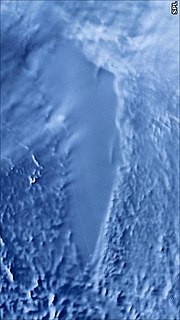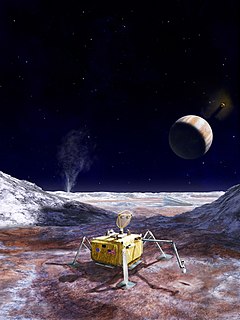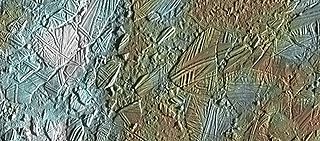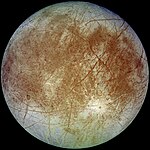
Callisto is the second-largest moon of Jupiter, after Ganymede. It is the third-largest moon in the Solar System after Ganymede and Saturn's largest moon Titan, and the largest object in the Solar System not to be properly differentiated. Callisto was discovered in 1610 by Galileo Galilei. At 4821 km in diameter, Callisto has about 99% the diameter of the planet Mercury but only about a third of its mass. It is the fourth Galilean moon of Jupiter by distance, with an orbital radius of about 1883000 km. It is not in an orbital resonance like the three other Galilean satellites—Io, Europa, and Ganymede—and is thus not appreciably tidally heated. Callisto's rotation is tidally locked to its orbit around Jupiter, so that the same hemisphere always faces inward; Jupiter appears to stand nearly still in Callisto's sky. It is less affected by Jupiter's magnetosphere than the other inner satellites because of its more remote orbit, located just outside Jupiter's main radiation belt.

Ganymede is the largest and most massive moon of Jupiter and in the Solar System. The ninth largest object in the Solar System, it is the largest without a substantial atmosphere. It has a diameter of 5,268 km (3,273 mi) and is 8% larger than the planet Mercury, although only 45% as massive. Possessing a metallic core, it has the lowest moment of inertia factor of any solid body in the Solar System and is the only moon known to have a magnetic field. Outward from Jupiter, it is the seventh satellite and the third of the Galilean moons, the first group of objects discovered orbiting another planet. Ganymede orbits Jupiter in roughly seven days and is in a 1:2:4 orbital resonance with the moons Europa and Io, respectively.

Lake Vostok is the largest of Antarctica's almost 400 known subglacial lakes. Lake Vostok is located at the southern Pole of Cold, beneath Russia's Vostok Station under the surface of the central East Antarctic Ice Sheet, which is at 3,488 m (11,444 ft) above mean sea level. The surface of this fresh water lake is approximately 4,000 m (13,100 ft) under the surface of the ice, which places it at approximately 500 m (1,600 ft) below sea level.
Icy moons are a class of natural satellites with surfaces composed mostly of ice. An icy moon may harbor an ocean underneath the surface, and possibly include a rocky core of silicate or metallic rocks. It is thought that they may be composed of ice II or other polymorph of water ice. The prime example of this class of object is Europa.

Enceladus is the sixth-largest moon of Saturn. It is about 500 kilometers (310 mi) in diameter, about a tenth of that of Saturn's largest moon, Titan. Enceladus is mostly covered by fresh, clean ice, making it one of the most reflective bodies of the Solar System. Consequently, its surface temperature at noon only reaches −198 °C (−324 °F), far colder than a light-absorbing body would be. Despite its small size, Enceladus has a wide range of surface features, ranging from old, heavily cratered regions to young, tectonically deformed terrains.

Connemara is a cultural region in County Galway, Ireland. The area has a strong association with traditional Irish culture and contains a major part of the Connacht Irish-speaking Gaeltacht, which is a key part of the identity of the region and is the largest Gaeltacht in the country.

Europa, the fourth-largest moon of Jupiter, is a subject in both science fiction and scientific speculation for future human colonization. Europa's geophysical features, including a possible subglacial water ocean, make it a possibility that human life could be sustained on or beneath the surface.

Extraterrestrial liquid water is water in its liquid state that naturally occurs outside Earth. It is a subject of wide interest because it is recognized as one of the key prerequisites for life as we know it and thus surmised as essential for extraterrestrial life.

Ravi Vallis is an ancient outflow channel, the source of which originates from the Aromatum Chaos depression, and is situated at the eastern end of Xanthe Terra, in the Margaritifer Sinus quadrangle (MC-19) region of Mars, located at 0.2°S 40.7°W. The Ravi Vallis outflow channel is 205.5 km (127.7 mi) long, and starts at the northeastern end of the Aromatum Chaos depression. The channel is orientated in an easterly direction, and further down channel, Ravi Vallis divides into two; a larger northern channel, and a smaller southern channel, and is finally truncated by a fault which is located at the western margin of the Hydraotes Chaos depression. Ravi Vallis was named after the Ravi River, an ancient Indian river.
An ice planet is a theoretical type of exoplanet with an icy surface of volatiles such as water, ammonia, and methane. Ice planets consist of a global cryosphere. They are bigger versions of the small icy worlds of the Solar System, which includes the moons Europa, Enceladus, and Triton, the dwarf planets Pluto and Eris, and many other small Solar System bodies such as comets.
Laplace-P is a proposed orbiter and lander by the Russian Federal Space Agency designed to study the Jovian moon system and explore Ganymede with a lander.

The JUpiter ICy moons Explorer (JUICE) is an interplanetary spacecraft in development by the European Space Agency (ESA) with Airbus Defence and Space as the main contractor. The mission is being developed to visit the Jovian system and is focused on studying three of Jupiter's Galilean moons: Ganymede, Callisto, and Europa all of which are thought to have significant bodies of liquid water beneath their surfaces, making them potentially habitable environments. The spacecraft is set for launch in June 2022 and would reach Jupiter in October 2029 after five gravity assists and 88 months of travel. By 2033 the spacecraft should enter orbit around Ganymede for its close up science mission and becoming the first spacecraft to orbit a moon other than the moon of Earth. The selection of this mission for the L1 launch slot of ESA's Cosmic Vision science programme was announced on 2 May 2012. Its period of operations will overlap with NASA's Europa Clipper mission, also launching in 2022.

Europa Clipper is an interplanetary mission in development by NASA comprising an orbiter. Set for a launch in June of 2023, the spacecraft is being developed to study the Galilean moon Europa through a series of flybys while in orbit around Jupiter.
Connemara is a district in the west of Ireland. Connemara or Conamara may also refer to:

Aromatum Chaos is a deep depression, in what is considered chaotic terrain. It is the source of the outflow channel Ravi Vallis, and is situated at the eastern end of Xanthe Terra, in the Margaritifer Sinus quadrangle (MC-19) region of Mars, located at 1.09°S 317.0°E. Aromatum Chaos is 91.5 km (56.9 mi) in length, and has an average width of about 30 km (19 mi).

Europa Lander is a proposed astrobiology mission concept by NASA to Europa, a moon of Jupiter. If selected and developed, it would be launched separately in 2025 to complement the studies by the Europa Clipper orbiter mission.
The SUrface Dust Analyser (SUDA) is a time-of-flight mass spectrometer of reflectron-type that employs impact ionization and is optimised for a high mass resolution. The instrument was selected in May 2015 to fly on board the Europa Clipper mission, that is planned for launch between 2022 and 2024 to Jupiter's moon Europa.

SPINDLE is a 2-stage autonomous vehicle system consisting of a robotic ice-penetrating carrier vehicle (cryobot) and an autonomous submersible HAUV . The cryobot is designed to descend through an ice body into a sub-surface ocean and deploy the HAUV submersible to conduct long range reconnaissance, life search, and sample collection. The HAUV submesible will return to, and auto-dock with, the cryobot at the conclusion of the mission for subsequent data uplink and sample return to the surface.

















